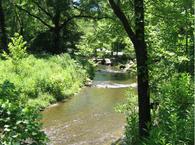The Yellowstone River starts in Wyoming near the Continental Divide, as a small freestone stream and it flows 39 miles to
Yellowstone Lake in Yellowstone National Park It continues from the lake, through the Yellowstone Canyon and Black Canyon before exiting into Montana at Gardiner. After leaving the park, it flows northward through Jim Yankee Canyon and Paradise Valley continuing north to the confluence with the Missouri River in North Dakota. At well over 600 miles in length, and up to 300 feet wide, it is widely known as the largest freestone river without an impoundment in the lower USA.
The Yellowstone River due to its size and characteristice can be divided into three major portions. The 39 mile portion of Yellowstone before the lake is extrememly remote and accessible primarily by horseback because it is often far from any road. The portion after leaving the northern boundary the park at Gardiner provides plenty of opportunity to catch some large browns and rainbows. However we are going to focus our attention on the most popular section: that which stretches from the lake to the northern boundary of the Yellowstone National Park.

This section within the Yellowstone national Park is most famous for the prized cutthroat trout and it can be further divided into two distince portions. The middle portion of the Yellowstone River below the Yellowstone Lake is wide, easy flowing and easily accessible as it flows to the Chittenden Bridge at the Grand Canyon. Despite the considerable pressure it is still capable of providing an excellent opportunity for anglers. From the road, it is possible to hike to the 7 mile hole although it is 5 miles to the trail. In this area the trout are abundant but the trail is difficult. Next is the Grand Canyon of the Yellowstone which contains a good deal of cutthroat but the upper portion of it is closed to fishing due to the steep walls of the canyon.
The lower portion of the Yellowstone river is 21 miles long stretching from the Grand Canyon to Gardiner. Access to this portion is from theYellowstone River Trail which follows the road somewhat being from one to four miles from the road. The easiest access for fishing is the first mile or so, and the last mile or so. There are several campsite along this portion of the river, and indeed from mile marker 21 to mile marker 330 at the headwaters, there are about 20 campsites with fishing access.
The snow melts slowly in the mountains of Wyomming and Montana so the spring runoff does not usually start until Mid May and the waters do not clear up sometimes until the July timeframe. However that is not a great concern since the general season for trout begins the Saturday of Memorial Day weekend and the season for the Cutthroat trout does not start until July 15. This protects the cutthroat spawn which takes place from June through early July. Please read the regulations for the park and the rules to protect the trout from aquatic nuisances before doing any fishing in the park.
Fishing the Yellowstone River:
The Mother’s Day Caddis hatch and the hatches of Salmonflies, Green Drakes as well as the Golden Stoneflies are well worth considering. Late summer sees the Caddis and Blue Winged Olive patterns become effective as well as the terrestrial patterns, esecially the hoppers. Terrestrials become hot due to the large meadows, and cotton wood stands that provide them a nice habitat. The wind in the large meadows and open areas will propel the hoopers into the water making them prime food for the trout but at the same time it is more difficult to cast a fly. Use a 5 WT rod to drive your hopper upstream attempting to lure the trout out from the undercut banks.
Late spring and summer:
This is an excellent time to fish the Yellowstone as the opportunity to catch the famous cutthroat is at its peak. There are some awesome hatches during this time as well.
Fall:
The fall season provides great action for the terrestrials due to the many meadows that provide a home for them and due to the wind that carries them into the water.

 This section within the Yellowstone national Park is most famous for the prized cutthroat trout and it can be further divided into two distince portions. The middle portion of the Yellowstone River below the Yellowstone Lake is wide, easy flowing and easily accessible as it flows to the Chittenden Bridge at the Grand Canyon. Despite the considerable pressure it is still capable of providing an excellent opportunity for anglers. From the road, it is possible to hike to the 7 mile hole although it is 5 miles to the trail. In this area the trout are abundant but the trail is difficult. Next is the Grand Canyon of the Yellowstone which contains a good deal of cutthroat but the upper portion of it is closed to fishing due to the steep walls of the canyon.
This section within the Yellowstone national Park is most famous for the prized cutthroat trout and it can be further divided into two distince portions. The middle portion of the Yellowstone River below the Yellowstone Lake is wide, easy flowing and easily accessible as it flows to the Chittenden Bridge at the Grand Canyon. Despite the considerable pressure it is still capable of providing an excellent opportunity for anglers. From the road, it is possible to hike to the 7 mile hole although it is 5 miles to the trail. In this area the trout are abundant but the trail is difficult. Next is the Grand Canyon of the Yellowstone which contains a good deal of cutthroat but the upper portion of it is closed to fishing due to the steep walls of the canyon.




